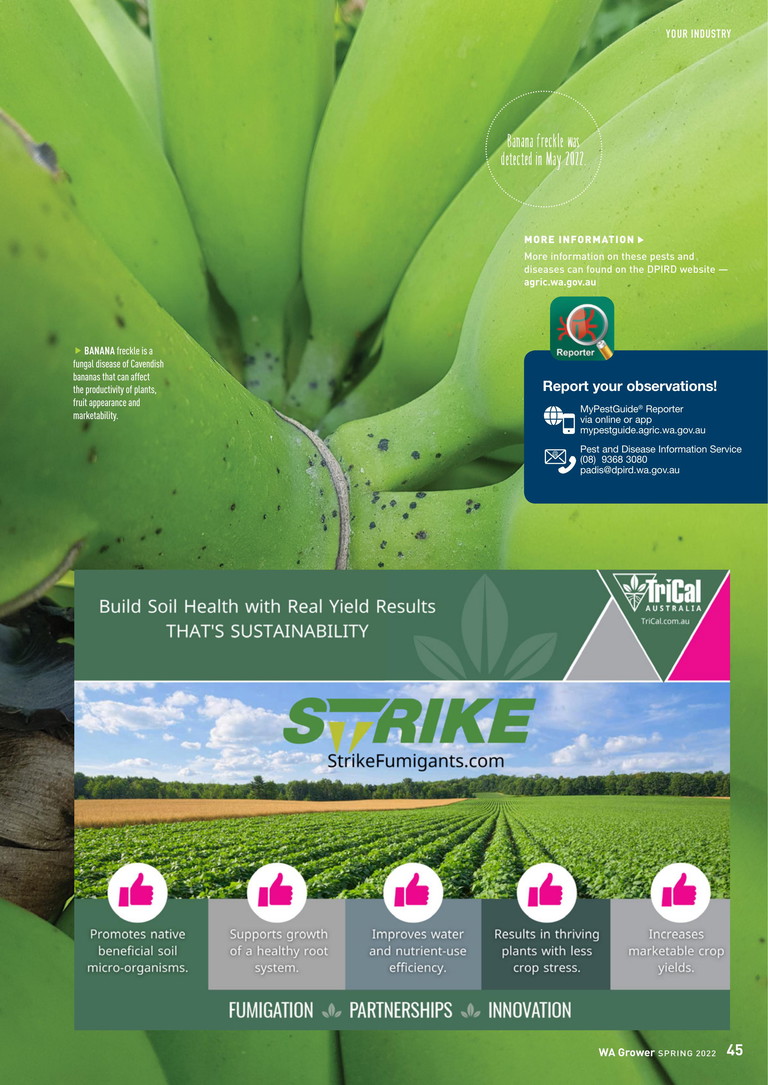Growers need to be on
high alert
Farm biosecurity, and reporting any concerning pests or disease symptoms needs to be at the top of every grower’s list, with the last few months being dominated by biosecurity issues.
Everyone is thinking about the threat of foot and mouth disease, but our plant industries have also been put at risk. There have been a number of exotic pest and disease detections in WA, and detections in other states have put WA on guard.
Recent detections
The detection of myrtle rust in the Kimberley region in July 2022 has created a threat not only to the State’s forests and bushland, but also the nursery industry. WA had previously been free of myrtle rust, and now South Australia is the only State where it has not been detected.
This devastating disease attacks Myrtaceae plants including peppermint trees, Geraldton wax, eucalypts, melaleucas, bottlebrushes and lilly pilly.
The Department of Primary Industries and Regional Development (DPIRD) and the Department of Biosecurity, Conservation and Attractions are working together to determine if the disease is present in other parts of the Kimberley.
In April 2022 blueberry rust was detected in a WA nursery. In response to the detection, tracing, surveillance and awareness activities led to detections in multiple locations.
DPIRD has been escalating its preparedness measures.
In consultation with industry, it was concluded that blueberry rust was not technically feasible to eradicate from Western Australia. This increases the need for growers to be ever-vigilant for signs of disease, and to take action to limit it’s spread if found.
The eradication program for polyphagous shot-hole borer (PSHB) continues, following its detection on a maple tree in an East Fremantle backyard. A Quarantine Area which covers 21 local government areas remains in place.
PSHB is a beetle from Southeast Asia that attacks a wide range of plants by tunnelling into trunks, stems and branches. In susceptible trees, the symbiotic relationship with a fungus causes dieback and trees begin to die.
What to keep watch for
DPIRD has been escalating its preparedness measures for a number of destructive pests exotic to WA that have been found in other states.
This includes Varroa mite, which was detected in New South Wales in June 2022. Varroa mite is an external parasite of honey bees and considered to be the greatest threat to Australia’s honey and honey bee pollination plant industries.
Detections of Mango shoot looper and Banana freckle in the Northern Territory have also put WA on high alert.
Banana freckle was detected in May 2022. It is a fungal disease of Cavendish bananas that can affect the productivity of plants, and fruit appearance and marketability.
Mango shoot looper, detected earlier this year, is an invasive pest of mango and lychee trees. It is an exotic moth species that feeds on leaves, tender shoots, flowers and immature fruit, reducing yields and causing stress on plants. Adult moths can fly and spread naturally between host trees, and strong winds.

MYRTLE rust is a highly invasive fungal disease of Myrtaceae plants including peppermint trees, Geraldton wax, eucalypts, melaleucas, bottlebrushes and lilly pilly. The disease was detected in the Kimberley in June 2022.
